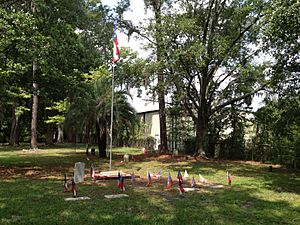Skirmish at Cedar Creek facts for kids
Quick facts for kids Skirmish at Cedar Creek |
|||||||
|---|---|---|---|---|---|---|---|
| Part of the American Civil War | |||||||
 Camp Captain Mooney Cemetery |
|||||||
|
|||||||
| Belligerents | |||||||
| Casualties and losses | |||||||
| 10
(2 killed
3 wounded) |
19
(5+ killed
12 wounded 6 captured/missing) |
||||||
The Skirmish at Cedar Creek was a small fight during the American Civil War. It happened in what is now Jacksonville, Florida, on March 1, 1864. This battle is also known as Camp Mooney or McGirt's Creek. It involved a small group of Confederate soldiers and the 40th Massachusetts Volunteer Infantry from the Union Army. In total, 29 soldiers were hurt or killed. This was the last fight in the Olustee Campaign.
Contents
Why the Skirmish Happened
Jacksonville, Florida was a key city during the American Civil War. Union forces took control of it several times. In February 1864, Union General Truman Seymour led his troops west from Jacksonville. Their goal was to bring Florida back into the Union. They also wanted to recruit enslaved people to join the Union Army.
Confederate forces stopped the Union advance. They defeated General Seymour's troops at the Battle of Olustee. This major battle happened near Lake City, Florida, on February 20. After their victory, Confederate soldiers stayed west of Jacksonville. They wanted to keep Union forces from moving further out.
The Fight at Cedar Creek
On the morning of March 1, 1864, a group of Confederate soldiers rode east. They were part of the 2nd Florida Cavalry. Their mission was to check on the Union defenses near Jacksonville. At the same time, a Union cavalry group left Camp Mooney. They were from the 40th Massachusetts regiment.
This Union group included soldiers from the 1st Massachusetts Cavalry. They also had some Massachusetts infantry and one cannon. Major Stevens led this expedition. They headed west to find the Confederate soldiers.
First Contact
Around mid-morning, the 2nd Florida Cavalry met the Union forces. This happened about two miles west of Camp Finegan. Soon, more Confederate soldiers arrived to help. They pushed the Union forces back through Camp Finegan.
Stand at Cedar Creek
The Union soldiers made a stand at Cedar Creek. The creek acted as a natural barrier. This made it harder for the Confederates to advance. A short but fierce fight broke out there. However, the Union troops were forced to retreat again. They fell back to an area called Three Mile Run.
The Confederates followed them. But the Union soldiers guarding the rear set up an ambush. They surprised the Confederates, killing Captain Winston Stephens and another soldier. The Confederate infantry then managed to cross Cedar Creek. They continued to move toward Jacksonville.
Retreat and Reinforcements
Union forces met up with more soldiers from Camp Mooney. They were ordered to go back to Cedar Creek. But they retreated again to their strong defenses at Three Mile Run. By the end of the day, seven Confederates were killed. Twelve were wounded, and six were captured or went missing. The Union lost two killed and three wounded.
The Confederates stayed in the area. They guarded it to prevent more Union attacks. The Union Army held Jacksonville for the rest of the war.
Camp Captain Mooney Cemetery
Camp Captain Mooney Cemetery was created on the same day as the battle. The cemetery is named after the Camp Captain Mooney outpost. This camp was near where the battle took place. The camp's name comes from Jesse E. Mooney of the Louisiana Militia. The cemetery is now owned by the United Daughters of the Confederacy.


